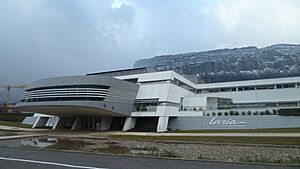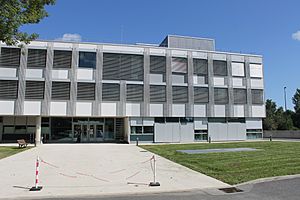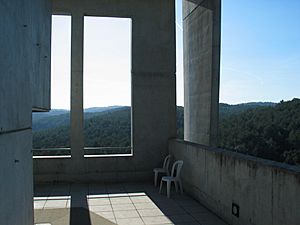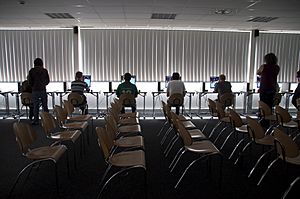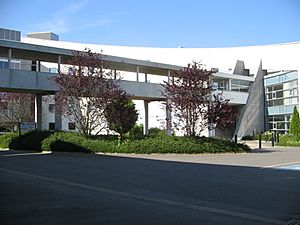French Institute for Research in Computer Science and Automation facts for kids
 |
|
| Abbreviation | Inria |
|---|---|
| Formation | 3 January 1967 |
| Type | Public |
| Purpose | Research |
| Headquarters | Le Chesnay-Rocquencourt, France |
| Fields | Computer science Applied mathematics |
|
Official languages
|
French, English |
|
President
|
Bruno Sportisse |
|
Budget
|
€235 million (2013) |
|
Staff
|
1,772 researchers |
|
Formerly called
|
Institut de recherche en informatique et en automatique |
The National Institute for Research in Digital Science and Technology (Inria) is a French research group. It focuses on computer science and applied mathematics. This means they study how computers work and how to use math to solve real-world problems.
Inria started in 1967 as the French Institute for Research in Computer Science and Automation (IRIA). Its first home was near Paris, in a building once used by NATO's military forces. This building is still Inria's main office today. In 1980, IRIA changed its name to INRIA, and since 2011, it has been known simply as Inria.
Inria is a public research organization. It works under the guidance of two French government ministries. These are the Ministry of National Education and the Ministry of Economy.
Contents
Where Inria Does Its Research
Inria has nine research centers located across France. These centers are in cities like Bordeaux, Grenoble, Lille, and Paris. There is also one international center in Santiago de Chile, Chile.
Inria also works with other research teams. For example, Inria Rennes is part of a joint research group called IRISA. This group includes several other organizations.
Before December 2007, the centers in Bordeaux, Lille, and Saclay were one big center. It was known as INRIA Futurs.
In October 2010, Inria teamed up with two universities. They started a new center called IRILL. This center focuses on new ideas and research for free software.
Inria has about 3,800 people working for it. This includes 1,300 researchers and 1,000 Ph.D. students. There are also 500 post-doctoral researchers.
What Inria Researches
Inria does both theoretical and practical research in computer science. Theoretical research explores new ideas. Practical research creates useful programs and tools.
Over the years, Inria has created many programs that people use widely. Some of these include:
- Bigloo: A programming language.
- CADP: A tool for checking how computer systems work together.
- Caml: Another family of programming languages.
- This includes versions like Caml Light and OCaml.
- Chorus: An operating system for distributed computers.
- Coq: A tool that helps prove things in mathematics and computer science.
- CYCLADES: An early computer network that helped develop the internet.
- Eigen (C++ library): A library for working with numbers in computer programs.
- Esterel: A programming language for creating automated systems.
- medInria: Software used for looking at medical images, like MRI scans.
- GNU MPFR: A library for very precise calculations with numbers.
- OpenViBE: A software platform for brain-computer interfaces. These allow people to control computers with their thoughts.
- Pharo: An open-source programming environment.
- scikit-learn: A popular software package for machine learning. Machine learning is how computers learn from data.
- Scilab: Software for doing complex math calculations.
- SOFA: An open-source tool for simulating physics, often used in medical simulations.
- TOM: A language for finding patterns in data.
- ViSP: An open-source library for visual servoing. This helps robots see and move.
- XtreemFS: A file system for large computer networks.
- XtreemOS: An operating system for grid computing.
Inria is also a leader in Artificial Intelligence (AI) research in France. In 2019, it ranked 12th worldwide for its accepted research papers. These papers were presented at a major AI conference.
Inria's History and the Internet
In the summer of 1988, Inria made an important connection. Its Sophia-Antipolis center connected to the NSFNet in the United States. This connection used a satellite link. It was the first international connection to NSFNET.
This link allowed Inria researchers to access the US network. It also let NASA researchers in the US access an astronomy database in France. This was a big step for the Internet in France. For many years after this, the internet in France was mainly used for research and education.
See also
 In Spanish: Institut National de Recherche en Informatique et en Automatique para niños
In Spanish: Institut National de Recherche en Informatique et en Automatique para niños


